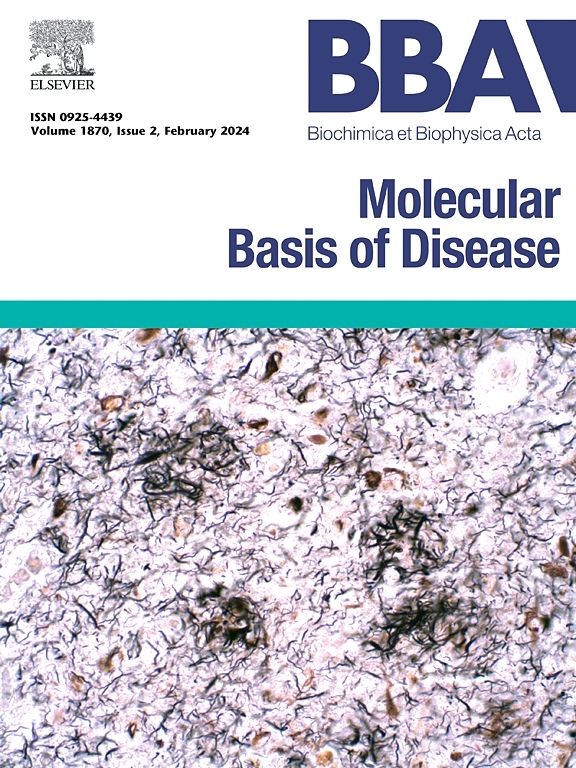HUWE1-mediated ubiquitination and degradation of oxidative damage repair gene ATM maintains mitochondrial quality control system in lens epithelial cells
IF 4.2
2区 生物学
Q2 BIOCHEMISTRY & MOLECULAR BIOLOGY
Biochimica et biophysica acta. Molecular basis of disease
Pub Date : 2025-03-11
DOI:10.1016/j.bbadis.2025.167796
引用次数: 0
Abstract
Mitochondrial dysfunction, resulting from a diminished oxidative damage repair capacity of mitochondrial DNA (mtDNA) in peripheral lens epithelial cells (LECs), is a key pathogenic mechanism in age-related cortical cataract (ARCC). This study aims to investigate the potential role of the E3 ligase HUWE1 and its ubiquitination substrate, the oxidative damage repair gene ATM, in the pathogenesis of ARCC. Our findings reveal that ATM protein expression is downregulated in human peripheral lens epithelial cells and the turbid cortex, correlating with increased expression of HUWE1. Overexpression of ATM is shown to repair damaged mtDNA, protect mitochondria in LECs from oxidative damage, inhibit mitochondrial fission, enhance mitochondrial biogenesis and mitophagy, and prevent LECs apoptosis. Conversely, overexpression of HUWE1 may negate the protective effects of ATM via the ubiquitination pathway, promote oxidative stress-induced mitochondrial damage, increase the expression of mitochondrial fission proteins Drp1/Fis1, lead to mitochondrial network fragmentation and LECs apoptosis. In a SD rat lens model ex vitro, the ATM inhibitor AZD0156 exacerbated lens opacity, whereas the mitochondrial fission inhibitor Mdivi-1 restored lens transparency. These results suggest that modulating key molecules involved in oxidative damage repair and mitochondrial fission pathways could enhance mitochondrial quality control, paving the way for the development of targeted molecular therapies for the prevention and treatment of ARCC.
huwe1介导的泛素化和氧化损伤修复基因ATM的降解维持晶状体上皮细胞线粒体质量控制系统。
外周晶状体上皮细胞(LECs)线粒体DNA (mtDNA)氧化损伤修复能力降低导致的线粒体功能障碍是年龄相关性皮质性白内障(ARCC)的关键致病机制。本研究旨在探讨E3连接酶HUWE1及其泛素化底物氧化损伤修复基因ATM在ARCC发病机制中的潜在作用。我们的研究结果表明,ATM蛋白在人类外周晶状体上皮细胞和浑浊皮层中的表达下调,与HUWE1表达增加相关。ATM的过表达可修复受损的mtDNA,保护LECs线粒体免受氧化损伤,抑制线粒体裂变,促进线粒体生物发生和线粒体自噬,防止LECs凋亡。相反,HUWE1过表达可通过泛素化途径抑制ATM的保护作用,促进氧化应激诱导的线粒体损伤,增加线粒体裂变蛋白Drp1/Fis1的表达,导致线粒体网络断裂和LECs凋亡。在离体SD大鼠晶状体模型中,ATM抑制剂AZD0156加重了晶状体混浊,而线粒体裂变抑制剂Mdivi-1恢复了晶状体透明度。这些结果表明,调节参与氧化损伤修复和线粒体分裂途径的关键分子可以增强线粒体质量控制,为开发靶向分子疗法预防和治疗ARCC铺平道路。
本文章由计算机程序翻译,如有差异,请以英文原文为准。
求助全文
约1分钟内获得全文
求助全文
来源期刊
CiteScore
12.30
自引率
0.00%
发文量
218
审稿时长
32 days
期刊介绍:
BBA Molecular Basis of Disease addresses the biochemistry and molecular genetics of disease processes and models of human disease. This journal covers aspects of aging, cancer, metabolic-, neurological-, and immunological-based disease. Manuscripts focused on using animal models to elucidate biochemical and mechanistic insight in each of these conditions, are particularly encouraged. Manuscripts should emphasize the underlying mechanisms of disease pathways and provide novel contributions to the understanding and/or treatment of these disorders. Highly descriptive and method development submissions may be declined without full review. The submission of uninvited reviews to BBA - Molecular Basis of Disease is strongly discouraged, and any such uninvited review should be accompanied by a coverletter outlining the compelling reasons why the review should be considered.

 求助内容:
求助内容: 应助结果提醒方式:
应助结果提醒方式:


